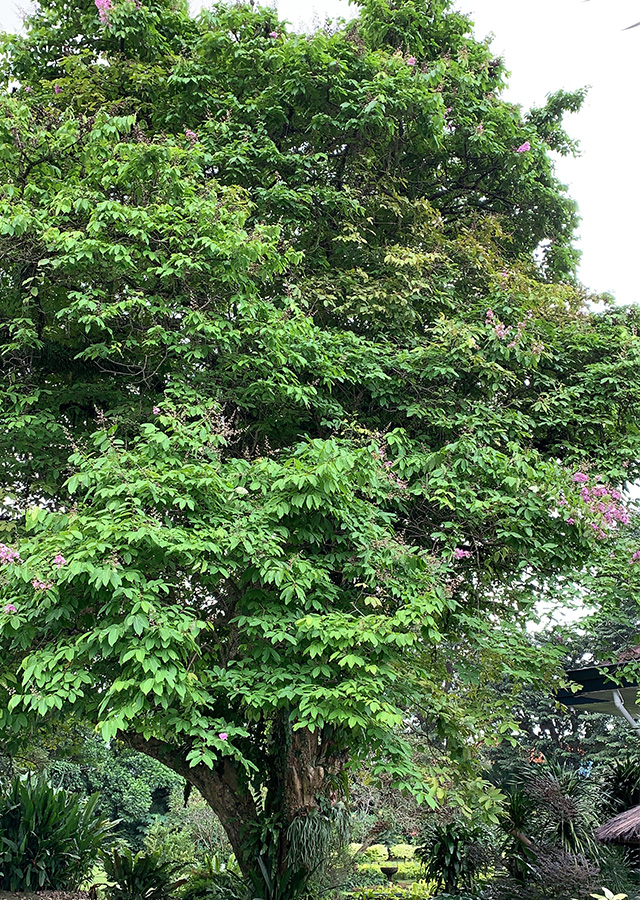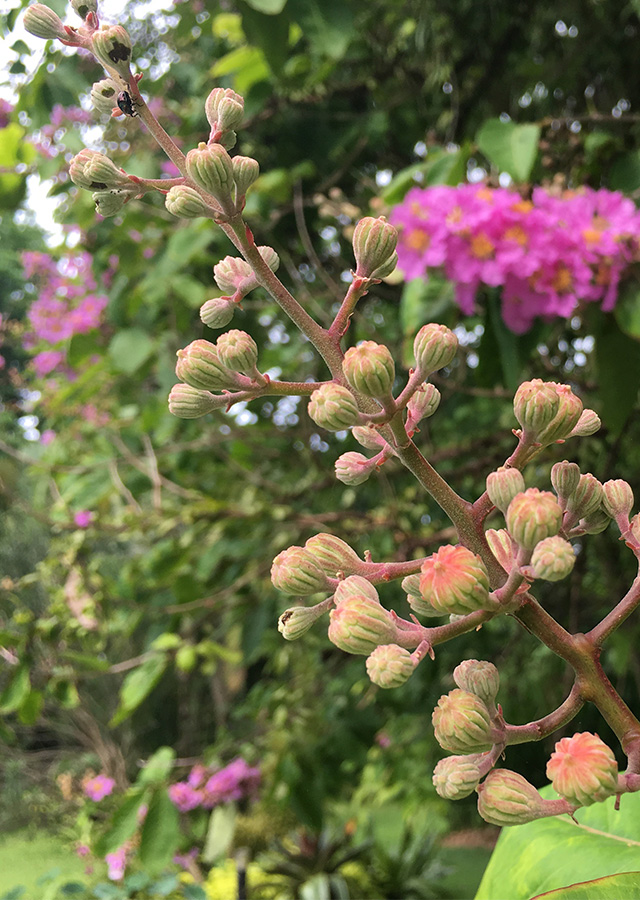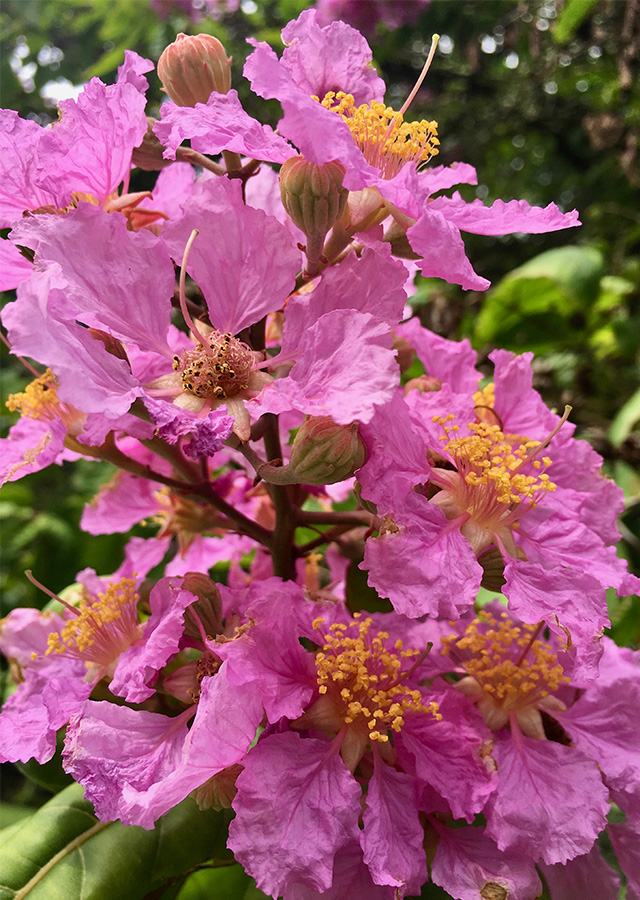Pride of India
Lagerstroemia speciosa (L.) Pers.
Lythraceae
Location in our garden
Principal



Synonym
Adambea glabra Lam.
Lagerstroemia flos-reginae Retz.
Murtughas hirsuta (Lam.) Kuntze
Habitus
Trees. A perennial shrub to large tree with multiple trunks or stems up to 45 m tall and 150 cm in diameter
Part Used
Leaves
Seeds
Bark
Flowers
Roots
Growing Requirements
Full Sunshine
Habitat
Riverbanks
Forest
Coastal
Overview
India's Pride is indigenous to contemporary China (Yunnan) to South-East Asia. In India, Malaysia, and the Philippines, it is widely distributed. For ornamental purposes and as roadside trees, it is also extensively commercial. In the horticulture industry, this species is highly valued for its big, showy, bright pink to lavender flowers. It is currently classified as invasive in the Virgin Islands, Belize, Costa Rica, and Puerto Rico.
Vernacular Names
Queen of fowers (English), Bungur (Indonesia), Bungur tekuyung (Sumatera), Lilas des Indes (French), Astromelia (Spanish), Koninginnebloem (Netherlands), Bungor raya (Malaysia), Chuang-muu (Thailand), Banaba (Philippines), Gawkng-uchyamang (Myanmar), B[awf]ng l[aw]ng n[uw][ows]c (Vietnamese).
Agroecology
A plant of the humid, lowland tropics and subtropics, where it is found up to 400 m elevation. In areas where annual daytime temperatures are within the 18-35 °C range, it grows best but can withstand 6-43 °C. The plant can withstand temperatures down to about -2 °C when dormant, but young growth at -1 °C can be seriously damaged. Average annual precipitation in the range of 2,000-3,500 mm is preferred, but 1,300-5,000 mm is tolerated. Its habitat is in open area, in disturbed or secondary forest, grassland, and along rivers.
Morphology
- Bark - smooth, gray to cream-colored, and peels off in irregular flakes.
- Leaves - smooth, large, spatulate, oblong to elliptic-ovate, 4 to 8 cm in width, 12-25 cm in length, shedding its leaves the first months of the year.
- Flowers - in a large, axillary or terminal panicle, often showy, calyx funnel or bell shaped.
- Fruit - a large nut-like capsule, obovoid or ellipsoid, and 2 to 3.5 cm long.
- Seed - pale brown, with an apical wing 12-18 mm long.
Cultivation
L. speciosa spreads primarily by seeds. However, propagation by cuttings and by division of root suckers is feasible in cultivation.
Chemical Constituents
Flavonoids, saponins, tannins, corosolic acid, ellagitannin lagerstroemin, gallotannin, steroid, terpenoid, antraquinones glycoside, phenolic compounds, amino acid, alkaloids, essential oils (terpineol, pinene, mycrene, bisabolene).
Traditional Medicinal Uses
- It is used for treating the benefits of blood pressure, the renal system, and the immune system.
- The research evaluated the antinociceptive, antidiarrheal, and cytotoxic activities of dried fruit extract.
- It may lower blood sugar and, when taken along with antidiabetic drugs, can cause blood sugar to go too low.
- Seeds, often used against aphthae, are known to have narcotic properties.
- A bark decoction against diarrhoea and stomach pain is used.
- To alleviate malarial fever, a leaf poultice is used.
- A dried leaf preparation known as "banaba" is commonly used in the treatment of diabetes and urinary problems throughout Asia.
- To promote bowel movements, the bark, flowers and leaves are used.
- Decoction is used for fevers and as a diuretic for leaves and flowers.
- Fruit or roots decoction for aphthous stomatitis gargled.
Part Used
Reference Sources
- CABI. (2017). Invasive Species Compendium. Lagerstroemia speciosa (Pride of India). https://www.cabi.org/isc/datasheet/29704. 27.07.2020
- Fern, Ken. (2019). Useful Tropical Plants. Lagerstroemia speciosa. http://tropical.theferns.info/viewtropical.php?id=Lagerstroemia+speciosa. 7.12.2020
- GlobinMed. (No date). Lagerstroemia speciosa (L.) Pers. https://www.globinmed.com/index.php?option=com_content&view=article&id=79433:lagerstroemia- speciosa-l-pers&catid=8&Itemid=113. 07-12-2020
- NCBI. (2007). Antidiabetes and Anti-obesity Activity of Lagerstroemia speciosa. https://www.ncbi.nlm.nih.gov/pmc/articles/PMC2176148/. 27.07.2020
- StuartXchange. (2020). Philippine Medicinal Plants: Banaba. http://www.stuartxchange.org/Banaba.html 7-1-2020


